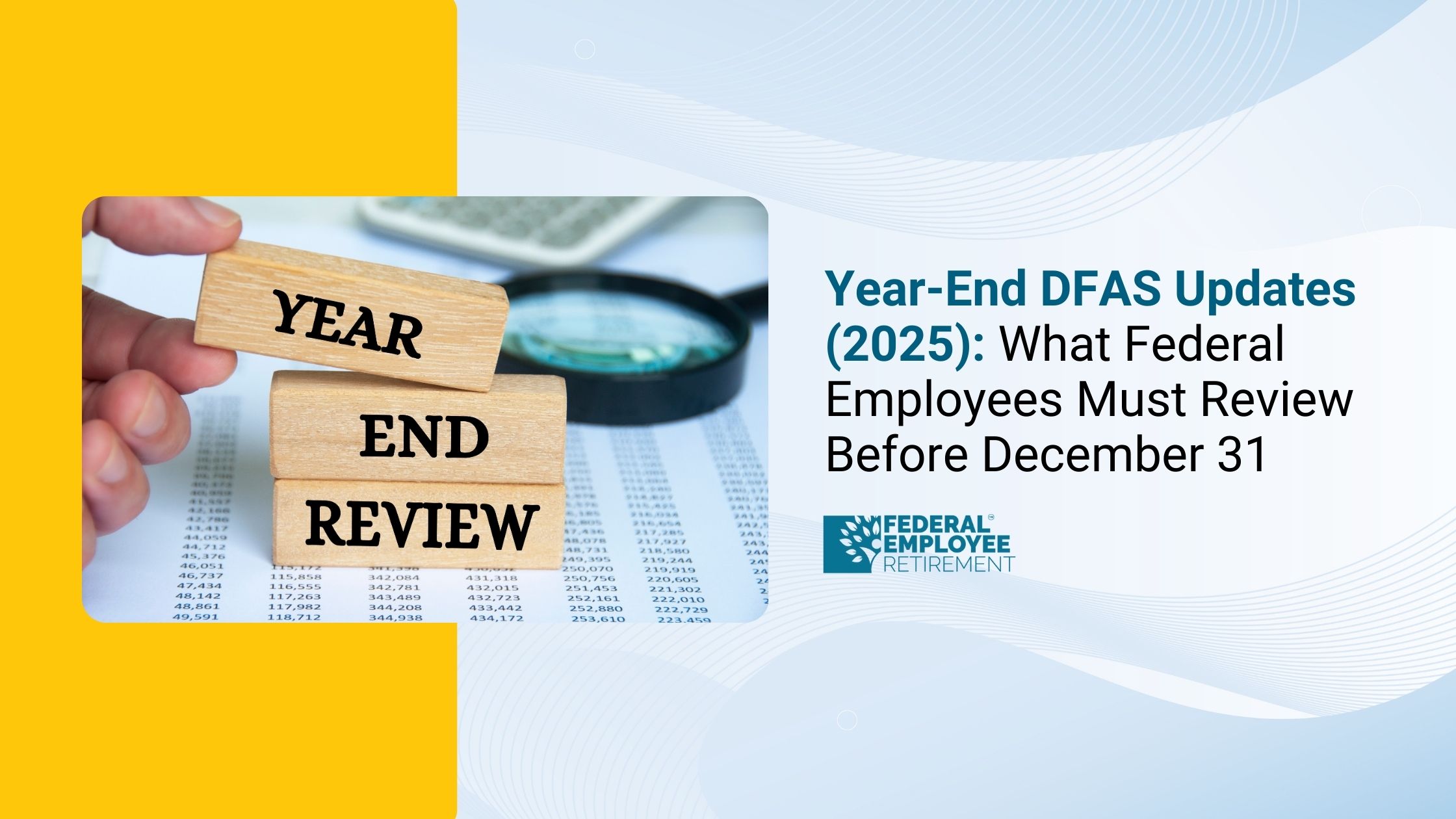You’re not alone; 4,359 federal employees booked their free review.
.jpg)
FERS MRA: Federal Employees Retirement System (FERS) Eligibility And Minimum Retirement Age (MRA)
The Federal Employees Retirement System (FERS) was established in 1986 and came into effect on 1 January 1987. It covers the majority of new federal civilian employees hired after that date. FERS provides retirement benefits from three main sources:
- Basic Benefit Plan: This is a defined benefit plan that offers a monthly annuity based on your salary and years of service. Both you and your agency contribute to the Basic Benefit Plan.
- Social Security: FERS participants are also eligible for Social Security benefits. You pay Social Security taxes, and your agency matches these contributions.
- Thrift Savings Plan (TSP): The (Thrift Saving Plan)TSP is a tax-deferred retirement savings plan, similar to a 401(k). You contribute a portion of your salary to the TSP, and your agency may also make matching contributions. You can invest your TSP contributions in various options such as stocks, bonds, and funds.
Unlike some other retirement plans, the TSP and Social Security elements of FERS can be transferred to your next employer if you leave federal service before retirement, allowing you to continue benefitting from these retirement savings even if you change jobs.
The Basic Benefit Plan and Social Security are mandatory for FERS participants, with the cost of these benefits deducted from your salary. Once you retire, you will receive annuity payments from both the Basic Benefit Plan and Social Security for the remainder of your life.
Also read - mra 10 retirement
What is the FERS MRA and the Minimum Retirement Age (MRA) for Federal Employees?
MRA FERS is the Minimum Retirement Age (MRA) is the earliest age at which a federal employee can retire with an immediate retirement benefit under the Federal Employees Retirement System (FERS). The MRA varies depending on an employee’s birth year but typically ranges from 56 to 57 years.
Reaching your MRA unlocks several retirement options and is central to retirement planning for federal employees. The MRA is crucial in determining when one can start receiving retirement benefits without penalty, although other conditions, such as years of service, must also be met.
1. Age 60: If you've completed at least 20 years of creditable service, you can retire at age 60 without penalty.
2. Age 62: If you've completed at least 10 years of creditable service, you can retire at age 62 with a reduced annuity.
3. Unsatisfactory Service: If your agency determines that your service is unsatisfactory, you may be able to retire at age 60 regardless of your years of service.
How to Calculate Your MRA
To calculate the MRA, federal employees need to consider their birth year:
Born Before 1962: Your MRA is 57.
Born in 1962: Your MRA is 57 years and 6 months.
Born in 1963: Your MRA is 58 years old.
Born in 1964: Your MRA is 58 years and 6 months.
Born in 1965 or later: Your MRA is 59 years and 6 months.
A minimum 5 years of creditable civilian service is required
Service Requirement for Reduced Benefits
- 10 years of creditable svc (5 of which are civilian) and retire at MRA
- Separates from a position subject to FERS coverage
- Permanent reduction in annuity
Also read - Federal Employee Reitrement System
Early Retirement Options
While the MRA is the general requirement, you may have options for early retirement under certain conditions:
1. Age 60 and 20 Years of Service: You can retire at 60 with at least 20 years of creditable service.
2. Uniformed Services Retirement: Members of the uniformed services may have different retirement age requirements.
Impact of MRA on Retirement Planning
The MRA is an essential consideration in retirement planning, particularly for those in government or public service roles, as it determines when you can retire without facing major reductions in benefits.
The Minimum Retirement Age (MRA) plays a vital role in retirement planning for federal employees. Retiring at or after reaching your MRA generally allows you to avoid reductions in annuity benefits, provided you meet other service requirements. With the MRA+10 option, employees can retire as early as their MRA with at least 10 years of service, though this often comes with annuity reductions or the need to delay retirement to avoid them.
This makes the MRA a key factor in choosing retirement dates, calculating annuities, and maximising benefits. Planning strategically around your MRA can help ensure a smoother transition to retirement.
Key Considerations
- Early Retirement Penalties: Retiring before your Minimum Retirement Age (MRA) often means reduced benefits, which can significantly impact your financial plans, especially if you were counting on receiving full benefits.
- Delayed Retirement Benefits: Conversely, delaying your retirement beyond your MRA can result in higher benefits. This is advantageous for those looking to maximise their retirement income or who may need to continue working due to financial obligations.
- MRA Variations: Your MRA can differ based on your profession, employer, or specific retirement plan. It’s crucial to understand the regulations that apply to your situation.
- Health Considerations: Your health may also play a role in deciding when to retire. If health issues could limit your ability to continue working in later years, it might be wiser to retire earlier.
Federal Employee Retirement System (FERS)?
FERS is a retirement plan that benefits from three different sources: a Basic Benefit Plan, Social Security and the Thrift Savings Plan (TSP).
1. Overview of FERS
The Federal Employees Retirement System (FERS) is a retirement plan designed for federal civilian employees in the United States who began their service on or after 1 January 1987. It was established to replace the Civil Service Retirement System (CSRS), offering a more modern and flexible approach to retirement benefits.
This structure ensures that FERS provides federal employees with a balanced retirement plan that includes both guaranteed annuities and the flexibility of personal savings. Additionally, unlike its predecessor CSRS, FERS allows the portability of TSP and Social Security benefits if you leave federal service before retirement, ensuring continued retirement security even if you change jobs.
2. FERS vs. Other Retirement Plans
- Defined Benefit Plans: FERS is a hybrid plan, combining elements of defined benefit and defined contribution plans. Other defined benefit plans typically guarantee a specific monthly annuity based on your salary and years of service.
- Defined Contribution Plans: Defined contribution plans, like 401(k)s, give you control over your investments. However, your retirement income depends on your investment performance.
- Private Sector Retirement Plans: While FERS is specific to federal employees, private sector retirement plans often have similar features, such as defined benefits or defined contribution components.
Who is Eligible for FERS Retirement?
Eligibility for the Federal Employees Retirement System (FERS) is generally restricted to:
- Federal civilian employees: You must be a civilian employee of the federal government.
- Employees hired after 1 January 1987: If you were employed before this date, you may be covered by the Civil Service Retirement System (CSRS) or a combination of CSRS and FERS.
Additional eligibility criteria include:
- Minimum service: You must have completed at least 5 years of creditable service.
- Minimum Retirement Age (MRA): Typically, you need to reach your MRA, usually 57, to retire without penalty.
There are exceptions to these general eligibility rules, particularly for specific roles such as law enforcement officers or firefighters, where different retirement provisions may apply.
What are the Different Types of FERS Retirement?
- Single-Life Annuity: Provides payments for the duration of your life, but payments cease upon your death.
- Joint-Life Annuity: Offers payments for the rest of your life and continues to your spouse after your death.
- Joint-Life Annuity with 50% Survivor Option: Provides payments for the remainder of your life, with 50% of the payment continuing to your spouse after your death.
- Survivor Annuity: Ensures payments to your spouse after your death, but these payments are lower than what would be received under a joint-life annuity.
- Disability Retirement: If you become mentally or physically disabled and can no longer do your job, you can apply for disability retirement regardless of your age or how long you've worked. A medical board at TRS will review information from you and your doctor, like your medical history and test results, to certify your disability.
If approved and you have at least 10 years of service credit, you'll receive a monthly payment without any reduction for retiring early. If you have less than 10 years of service, TRS will pay a $150 monthly benefit until certain conditions are met, like how long you've been in TRS or the duration of your disability.
Applying and Planning for Retirement under FERS
1. Applying for FERS Retirement
- Gather Necessary Information: Collect all relevant documents, including your National Insurance number, birth certificate, and any military service records.
- Submit a Retirement Application: Contact your agency's human resources office to obtain the required forms and instructions for filing your retirement application.
- Provide Supporting Documentation: Submit any necessary documents to support your retirement claim, such as medical records if you're applying for disability retirement.
- Attend a Counselling Session: Many agencies offer retirement counselling sessions to help you understand your options and make informed decisions.
2. Planning for Retirement under FERS
- Understand Your Benefits: Familiarise yourself with the different components of FERS, including the Basic Benefit Plan, Social Security, and the Thrift Savings Plan (TSP).
- Estimate Your Retirement Income: Use retirement calculators or consult a financial adviser to estimate your projected retirement income.
- Create a Budget: Develop a detailed budget to account for your anticipated expenses in retirement.
- Consider Healthcare Costs: Include healthcare expenses, such as Medicare premiums and out-of-pocket costs, in your planning.
- Review Your Investment Strategy: If you have a TSP, review your investment strategy to ensure it aligns with your retirement objectives.
- Explore Additional Income Sources: Consider part-time work, rental income, or other income streams to supplement your retirement earnings.
Documents Needed for Application
To apply for FERS retirement, the following documents are typically required:
- Completed retirement application forms,
- Proof of federal employment and service credits,
- Birth certificates or proof of age,
- Marriage certificates (if applying for survivor benefits), and
- Financial records for calculating annuities.
In conclusion, understanding your Minimum Retirement Age (MRA) is crucial for federal employees planning their retirement under the Federal Employee Retirement System (FERS). Your FERS MRA determines when you can retire with full benefits or if there will be reductions based on early retirement choices. Planning ahead based on your MRA FERS ensures you can maximize your annuity payments, which are calculated using your highest three years of salary and the years you've worked. By retiring at the right age and with sufficient service, you can secure the highest possible pension payment, providing financial security during your retirement years.


Get Updated
Subscribe to our weekly updates for the latest on retirement planning, federal benefits, exclusive webinars, and more!
Download Federal Retirement: Step-by-step Checklist
This comprehensive guide will help you understand your federal benefits, optimize your savings, and plan for a comfortable future.



.png)








